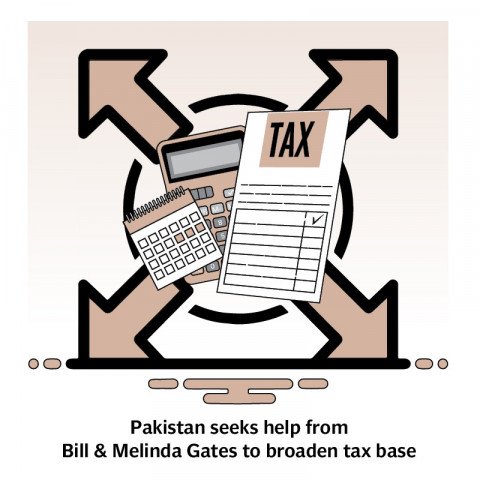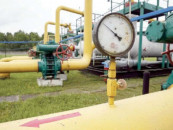Govt mulls help to expand tax base
Will approach Bill and Melinda Gates Foundation to seek financial assistance

As the number of active taxpayers further shrinks to 3.4 million, down 41% over the previous year, the government is considering seeking financial assistance from the Bill and Melinda Gates Foundation to improve digital services in the Federal Board of Revenue (FBR).
Compared to a week ago, the names of about 500,000 people were omitted from the Active Taxpayers List (ATL) for tax year 2023 due to their inability to timely submit the annual income tax returns. These people will have to pay a nominal penalty for inclusion in the list. The designated new economic czar, Muhammad Aurangzeb, on Friday chaired his first meeting to discuss the possibilities of improving digital services to broaden the tax base, according to the government officials.
The meeting was also attended by Karandaaz Pakistan, a firm engaged in financial inclusion services and having expertise in providing digital platforms with the assistance of foreign donors. It was decided that Karandaaz would approach the Bill and Melinda Gates Foundation to seek financial assistance for building a digital platform in the FBR, confirmed two participants of the meeting.
The government is planning to minimise interaction between taxmen and taxpayers to increase transparency and reduce opportunities of corruption.
The development came as the number of active taxpayers further fell to a mere 3.4 million, according to the Active Taxpayers List published by the FBR this week.
According to last year’s list, the active taxpayers were over 5.7 million. This suggests a reduction of over 2.32 million, or 41%, in the tax base, which is alarming.
The FBR received 3.9 million income tax returns but about 500,000 did not file returns within the given time frame. Thus, their names were deleted from the active list, according to an FBR official.
As a result, the number of people who are entitled to the reduced income tax rates is just 3.4 million. Those who are not on the active taxpayers list would have to pay 0.6% withholding tax on cash withdrawal.
These roughly 500,000 people can again become active filers by paying a fine of just Rs1,000 for late filing of returns.
The government is going to face pressure from the International Monetary Fund (IMF) to broaden the tax base and reduce the number of tax slabs for salaried and business individuals.
Fresh data showed that tax contribution from the salaried class peaked at Rs217 billion in eight months (Jul-Feb) of the current fiscal year. Taxes paid by the salaried individuals were Rs37 billion, or one-fifth, more than the combined taxes paid by the rich exporters and real estate players.
Read: FBR detects over Rs8.5m tax evasion
Like other citizens, the salaried persons are also paying taxes on the use of services like digital payments through debit and credit cards and the use of internet, mobile and telephone services.
The FBR got Rs12.7 billion on overseas payments made through debit and credit cards, a sum that was 429% higher than the same period of last fiscal year.
Two days ago, Prime Minister Shehbaz Sharif supported the proposal to reduce tax slabs that would further increase the burden on salaried persons.
Speaking to newly elected members of the National Assembly on Thursday, the PM supported the idea of reducing the number of tax slabs.
The Express Tribune reported in December last year that the IMF had asked Pakistan to cut the number of tax slabs for the salaried and business class from the existing seven to four.
At present, income tax rates for the salaried class range from the low of 2.5% to the high of 35%, depending on the annual income. In case of deleting two or three tax slabs, the tax rates for people earning from Rs200,000 to Rs300,000 a month would increase sharply.
FBR officials said that the maximum tax was collected from people earning Rs200,000 to Rs300,000 a month.
There is no tax on the monthly income of up to Rs50,000. But on the income of Rs100,000, there is a tax of 2.5%. On the monthly income of Rs200,000, the rate increases to 12.5%. For the income of Rs300,000, the tax rate is 22.5% and for Rs500,000, the rate jumps to 27.5%. For the highest slab of over Rs500,000, the rate is 35%.
Details showed that the salaried class again remained the fourth-largest income tax contributor during the first eight months of the current fiscal year. It paid Rs217 billion in taxes, which was Rs62 billion, or 40%, higher than the same period of last year.
The additional tax that the salaried class paid was slightly higher than the total tax of Rs61.3 billion paid by the rich exporters. In the budget, the government, for the second time in one year, increased taxes on the salaried people earning more than Rs200,000 a month.
PM Shehbaz is considering increasing the tax burden further at a time when inflation is already at high levels due to a massive increase in prices of electricity, gas, heating and food.
Exporters paid only Rs61.3 billion in taxes during eight months, which was 255% less than the tax contribution by the salaried persons. The IMF is also wrongly putting more burden on the salaried class, which, unlike exporters and retailers, does not have a voice in power corridors.
Tax collection from contractors and service providers jumped 32% to Rs309 billion in eight months, the second highest contribution. The collection on account of profit on debt jumped 49% to Rs312 billion, the highest payment on the income tax side. Importers paid Rs256 billion in income tax on various types of imports, the third-largest contributor to withholding taxes.
Published in The Express Tribune, March 10th, 2024.
Like Business on Facebook, follow @TribuneBiz on Twitter to stay informed and join in the conversation.



















COMMENTS
Comments are moderated and generally will be posted if they are on-topic and not abusive.
For more information, please see our Comments FAQ